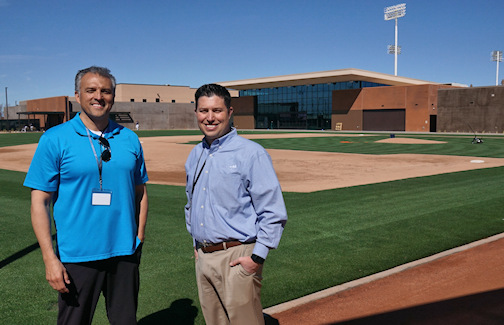
Text and photos by Joe Mock
All rights reserved
PHOENIX, ARIZONA David Stearns holds a title that is both lengthy and lofty: President — Baseball Operations and General Manager of the Milwaukee Brewers. When he sat down with the design and construction team that was to significantly renovate the team’s spring training facilities in Phoenix, he was quite direct. “He said from the very beginning that we want to create a Brewers Haven,” recalled Fred Ortiz, Principal at architecture firm HKS. “So we looked at how the complex was zoned and how the fans approach it, and came up with a plan.” Ortiz was given the responsibility of being the lead designer on the project.
HKS and construction firm Mortenson were tasked with re-imagining the spring training experience at the complex. It originally opened in 1998, but in the intervening years, it had fallen quite a bit behind behind what big-league teams expect these days. This was especially evident when you look at the other nine complexes in the Phoenix area, including the $84-million complex for the Cubs in Mesa and the Taj Mahal of all spring training facilities, Salt River Fields near Scottsdale.
The cost of converting the facilities into the Brewers Haven topped $60 million, borne largely by the team, with the City of Phoenix and the Arizona Sports and Tourism Authority also making contributions. The work was completed in time for 2019’s spring training.
 It even has a new corporate-sponsorship name, American Family Fields of Phoenix. American Family Insurance, you see, is a Fortune 500 firm headquartered in Wisconsin. In fact, their name will be replacing Miller on the team’s regular-season home later in 2020, as hard as it is to imagine that a team called the Brewers won’t be playing in Miller Park.
It even has a new corporate-sponsorship name, American Family Fields of Phoenix. American Family Insurance, you see, is a Fortune 500 firm headquartered in Wisconsin. In fact, their name will be replacing Miller on the team’s regular-season home later in 2020, as hard as it is to imagine that a team called the Brewers won’t be playing in Miller Park.
You might realize that the Phoenix neighborhood of Maryvale was prominent in the facility’s previous name of Maryvale Baseball Park. When I asked The Brewers’ Senior VP of Communications, Tyler Barnes, about it, he gave a very thoughtful answer. He noted that “our fans associate Spring Training with the city of Phoenix, and to that end we thought with a new complex and stadium in place, we should embrace the connection we have to the larger area.”
The notion of Maryvale isn’t disappearing entirely, though. “We wanted to keep the Maryvale identity as a tribute to John and Mary Long and their family, who created the master-planned community” beginning in the 1950s. Named as a tribute to Mary Long, Maryvale was credited as being the first truly planned community in the state of Arizona. In the mid-1990s, the Long family donated the land for the Brewers’ spring-training complex to be constructed.
“To that end,” Barnes continued, “we dedicated the home plate plaza as the John and Mary Long Plaza and relocated a rose garden as a tribute to the family’s contributions to the area and facility. That same rose garden and plaque were located at the entrance to the old stadium.”
I was given a tour of the newly renamed and massively rebuilt facilities by HKS’s Ortiz and Ben Goetter, General Manager at Mortenson. Barnes kicked off the tour for us.
While I expected to see state-of-the-art training and work-out areas for the players, I didn’t anticipate the profound impact the changes have on the experience of the fans. More on that shortly.
First, let’s walk through what I saw on the tour.
While a few structures were retained and re-purposed, there was a tremendous amount of new construction, particularly in the main clubhouse building. Its impressive reception area is shown below.
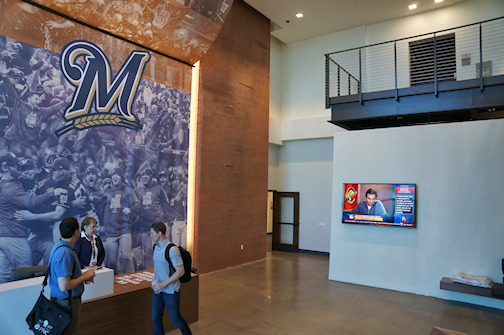
The areas for the trainers and for hydrotherapy (below) were brand new. In particular, the whirlpools and underwater treadmills are what really define a new spring-training facility from an older one, as Major League teams now demand these. I’ve viewed all of the new and renovated spring venues, and I don’t recall seeing as many tubs as here.

You knew the new Major League clubhouse would rival that of any in the big leagues, and this one doesn’t disappoint. I was relieved that it wasn’t oval shaped, as many of the new spring-training locker rooms are (I mean, you don’t want a sensitive big leaguer getting his feelings hurt if his locker is stuck in a corner!). While the Brewers’ new digs aren’t exactly rectangular, they do avoid the problem of what to do with the surrounding spaces that abut an oval room.
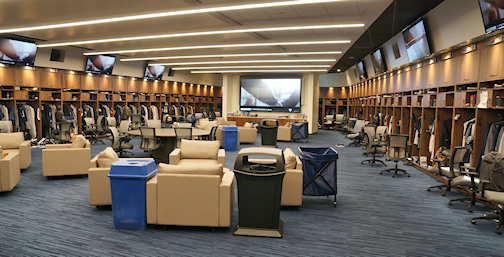
Another area that has leapt to prominence in athletic circles is nutrition. Gone are the days of big-league teams sending their high-priced talent off to Wendy’s and Burger King with a $15 per diem for food. Now the players dine together with the team’s nutritionists controlling the menu. Here is the big-league dining area for the Brewers, just a few steps down the hall from the clubhouse.

This is the door that players and club personnel (not the public) are likely to use when entering the new clubhouse building. The admonition is from former team owner and Commissioner of Baseball Bud Selig. Not only is it a nice touch, it’s something that those in the business of baseball — playing and operating teams — should heed.
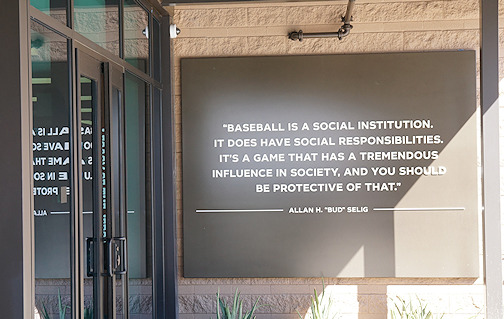
Once you step through those doors (or exit from the dining room or the weight room), you see an attractive outdoor element of the Brewers Haven. This space serves a dual purpose — a “half field” for infield practice and an agility field. The latter is another concept that didn’t exist in spring-training complexes of old, but now are incorporated into every new or remodeled site plan.
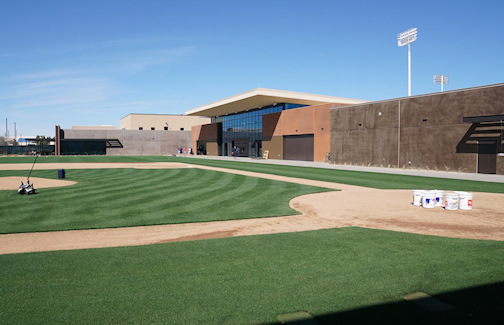
The Astros, by the way, also combine their agility field and half field in the new two-team complex in West Palm Beach, while their complex-mates the Nationals, keep them separate.
Below is another look at the Brewers’ agility field, taken from the plaza on the roof of the portion of the new clubhouse building that houses the team’s offices.

Another novel element that other teams will undoubtedly be demanding is shown below. Not only are these batting tunnels indoors, they are also air-conditioned. Of course, there are also quite a few other covered batting cages nearby — but without AC.

Ortiz explained that a lot of thought went into how the players move from one practice area to another — and circulate back to the clubhouse. Even these walkways are manicured and landscaped.

Speaking of pathways, the designers wanted to positively impact the way fans move throughout the complex — and did they ever! Since the previous plaza outside the main gates of the ballpark (which were on the first-base side of the park) is now where the new clubhouse building is located, this provided the opportunity to make major changes. The new walkway shown below connects the main parking lots for fans (located in the southeast corner of the complex) to the new plaza behind the stadium’s home plate. This walkway skirts the outfield of one of the practice fields for the Minor Leaguers.
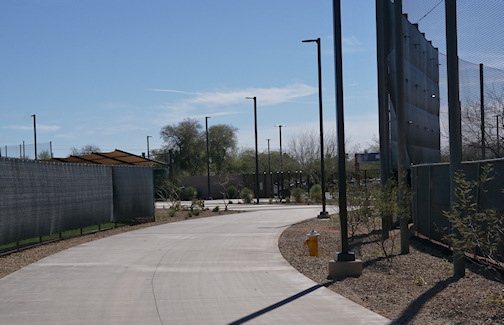
As you continue on this path toward the stadium, the scene in the photo at the top of this page appears before you. Talk about a huge upgrade from the previous experience! This is beautiful.
Along this sidewalk are attractive monuments honoring noteworthy members of the Brewers family, like Hall Of Fame broadcaster Bob Uecker. I especially like this shot, because it shows a father explaining who Uecker is to his family. Yes! I hope Dad relates that Ueck once said of his playing days, “I had slumps that lasted into the winter.”

Hammerin’ Hank, who has a statue outside of Miller Park, finished his big-league career where it started: Milwaukee. Of course he’s honored on this “walk of fame” in the complex.
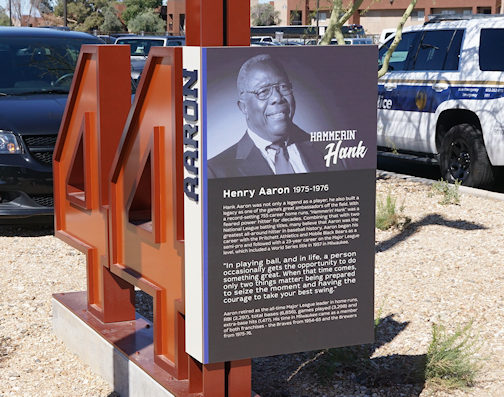
Perhaps the ballpark’s most prominent feature is the upper level that contains the suites and press area. That structure didn’t change significantly, but its bright blue color did. In fact, all around the complex now is a desert color scheme, somewhat like Camelback Ranch in nearby Glendale. Gone are the bright blues and stark whites.

This is the new entry plaza and gates behind the ballpark’s home plate. The shot is taken looking south from the upper level. Those are the Sierra Estrella Mountains in the distance.
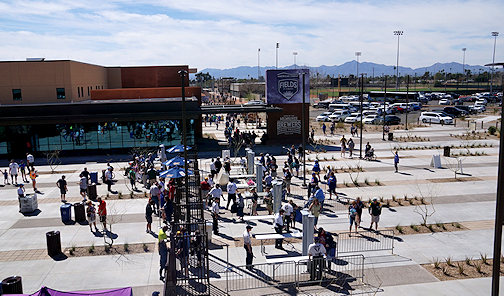
Just inside those entry gates is the spacious plaza named for John and Mary Long. In the past, the ballpark’s perimeter fence severely limited the space here. The windows in the building across the plaza are for the new souvenir shop.
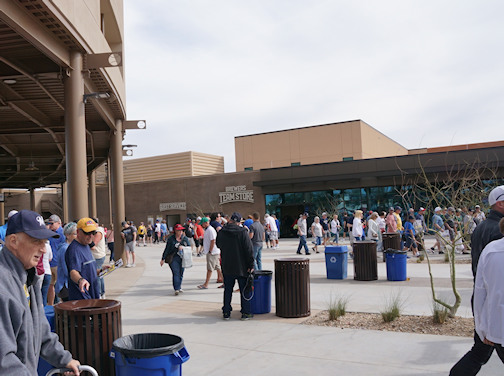
The area on the first-base side of the upper level used to have an open-air suite of sorts. It has now been enclosed and air conditioned, and can be rented by a group. This is the view from that suite.
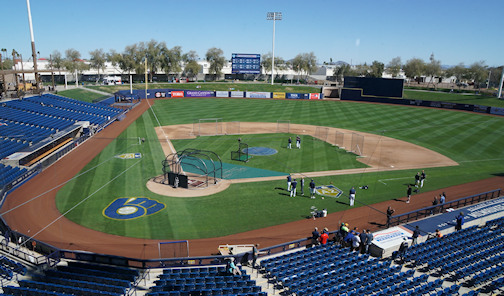
One fairly unpleasant experience of attending Brewers exhibition games in the past was the crowded madhouse that greeted you if you went into the team store. While that store still remains, it’s no longer considered to be the primary venue for shopping. The main store is all new and it’s a beauty. It’s just off the home-plate plaza, and it is four times the size of the old one. Thank goodness!
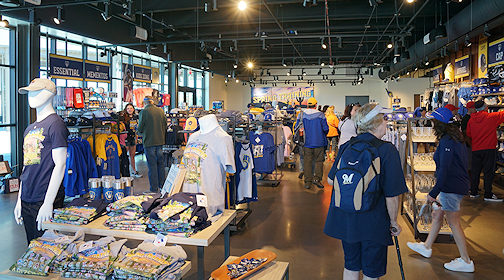
I’ve always loved the trellised coverings over the concourses at this ballpark. They are now a different color, though, to fit in with the desert scheme,. The concourses are also wider than before. This shot shows the concourse behind third base, but the first-base walkway is quite a bit wider, with space for stand-up tables. This is a welcome improvement.
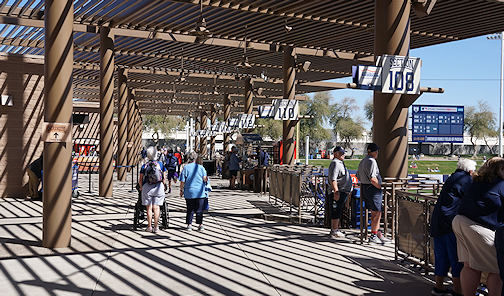
While the basic structure of the ballpark itself didn’t change radically, the wider concourses and new color scheme cause the place to have the feel of new facility. I liked it before, but I really like it now.

Two new features for 2019 are in the shot below. First is a set of stairs through the berm near the left-field foul pole. It’s used by visiting players and the umpires. Second is a gorgeous new video board. Like the player-development facilities, the old scoreboard had gotten quite tired-looking. The new board is a treat.

Here’s a closer look at the new stairs, as the visiting Padres depart the field following the game. As you would expect, youngsters flock to these stairs both before and after the contests.
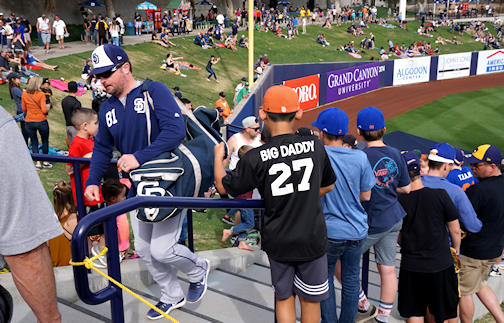
In summary, I thought I’d be impressed by the renovations in the Phoenix neighborhood of Maryvale, but I didn’t know I’d be blown away by them — especially the way the changes positively impact fans. I’m thankful I was given the opportunity to see it all.
Standing by the new agility field are my tour-guides for the day. Ortiz of HKS is on the left, and Goetter of Mortenson is on the right. I owe them both a great deal of gratitude — not only for their time with me, but also for making this complex a haven for both the Brewers’ players and fans.
